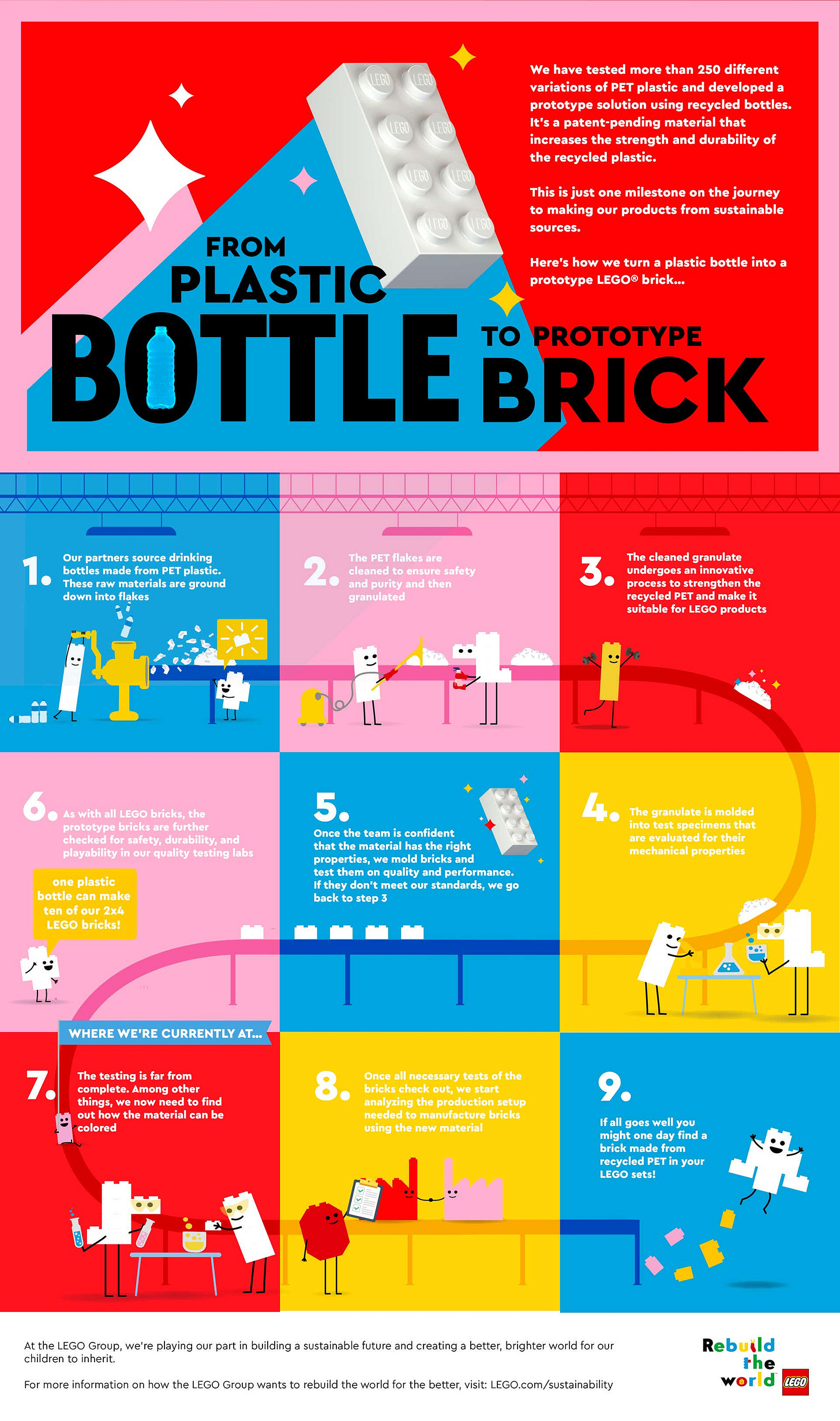Lego changes course, will recircle instead of recycle
They tried to make Lego bricks out of recycled PET and couldn't make it work, but we can all learn a lesson from this.
The Financial Times broke the story with the headline “Lego ditches oil-free brick in sustainability setback”- Lego was abandoning its effort to move away from oil-based plastics. Back in 2021, the company announced a prototype made with recycled Polyethylene terephthalate (rPET), the stuff of single-use water bottles. Tim Brooks, the Vice President for Environmental Responsibility, said at the time: “We are super excited about this breakthrough. The biggest challenge on our sustainability journey is rethinking and innovating new materials that are as durable, strong and high quality as our existing bricks.”
Except they weren’t. Acrylonitrile Butadiene Styrene (ABS) is harder than PET. Tim Brooks now tells FT that to make the rPET hard enough, they had to add ingredients and lots of extra energy to process and dry it. “It’s like trying to make a bike out of wood rather than steel.” In the end, the rPET bricks had a higher carbon footprint than the ABS ones. Brooks concludes, “It was disappointing.”
On Twitter, the usual skeptics and deniers are having a field day, claiming that “this proves that recycling is a scam!” Or, “Lego is putting profits ahead of the planet.” Sustainable Plastics calls it “a PR blow to the plastics recycling industry.”
But it’s not so simple for a number of reasons:
Plastics are wonderful materials that can be made into products that can last forever, like a Lego block or my grandmother’s Bakelite Mah Jong pieces that I played with as a child and that my Granddaughter is playing with today. They replaced those white ones made of ivory. Lego bricks can last as long. There is a huge difference between taking hydrocarbons and making single-use plastics and making something that can last a couple of lifetimes. Or, Michael Barnard notes on Linkedin, just burning them. “Tiny, durable, long-lived plastic products made from fossil hydrocarbons are not a problem. Burning fossil hydrocarbons in one-off highly wasteful uses is a problem.” The stuff is useful; A chemist notes: “ABS terpolymer is the ideal material for Lego(R) bricks due to its exceptional properties. Its high rigidity, dimensional, chemical and thermal stability, and resistance to impact make it the top choice for these toys. ABS can withstand years of usage and abuse without losing its structural integrity.”
PET bottles should be recycled into PET bottles. Turning them into Lego bricks just encourages the production of virgin PET because it is not a closed loop- more will be needed to make the new bottles. When the European Parliament was recently discussing the issue of downcycling PET bottles into textiles, Reloop and other organizations complained that “we have observed in recent years a worrying trend for non-food sectors to make green claims related to the use of recycled material coming from the food-grade recycling packaging the beverage sector puts on the EU market. This is not circularity!”
There are some fundamental thermodynamic laws in play here, notably the second law where the world tends to disorder and entropy. That’s why most recycled plastic ends up in lumber and benches; it tends to be easiest to make something of lower quality. Just turning PET bottles into PET bottles probably takes more energy to collect and separate and clean and flake and make into bottles than it took to make a bottle in the first place; it is no wonder that making a Lego brick uses even more energy and emits even more carbon.
The skeptics are right: recycling is a scam. As I noted in an earlier post, “The purpose of recycling was to make the world safe for single-use packaging. It worked.” We have been sold a bill of goods with recycling, where “the industry convinced us that single-use packaging would be dealt with so that we could happily consume without concern.” Instead of recycling PET, we should be getting rid of single-use plastics. There shouldn’t be an endless supply of PET water bottles; we should be reusing and refilling cups, glasses and bottles.
Lego gets this. They have started a Replay program in North America where they take back donated bricks, clean them up and send them to charity. According to the FT article, which most people didn’t read to the bottom, Brooks said Lego is looking at ways to commercialize this, where people could sell back their old sets, which could be repackaged and resold. Brooks concludes:
“It’s better to reuse than recycle. So we’re looking at a circular business model — how do we earn revenue from recircling bricks. It’s quite a shift in thinking and ideas.”
This is true circularity! It takes a lot less energy to recircle (a term I have never heard before, but I like it!) than recycle. After all the press, good and bad, generated by the FT article, Lego issued a press release discussing the failure of the rPET brick:
This is the nature of innovation – especially when it comes to something as complex and ambitious as our sustainable materials programme. Some things will work, others won’t. We have learned a lot and will apply those learnings as we continue to develop new materials and explore other ways to make our bricks more sustainable. We believe it’s important we’re transparent about our sustainability efforts.
Good for them. And thanks to Lego for a great example of how recycling should be the last of the Rs after Reuse and our new ones, Return, Repackage, Resell and my favourite new word, Recircle.







Lloyd,
Thank you for this article! It is vital for us all to realize the difference between single-use or short-use plastics and durable life-long plastics. Lego tried and tested and analyzed the results of bio-based bricks, and, although I will always cherish those test components in my Lego sets, has realized this is a distraction to the real potential in how they do business. Kudos to them.
In tying this to the building industry - let's focus on building building for the exceptionally long life they can have and in a way that reduces operational carbon to null, and embodied carbon as much as possible, while eliminating toxins from those materials. Let's focus on how those buildings will serve, be updated, serve for longer, and inspire generations.
Looking forward to your comments on the long-awaited demise of the pathetic version of TREEHUGGER after you were forced out Lloyd...